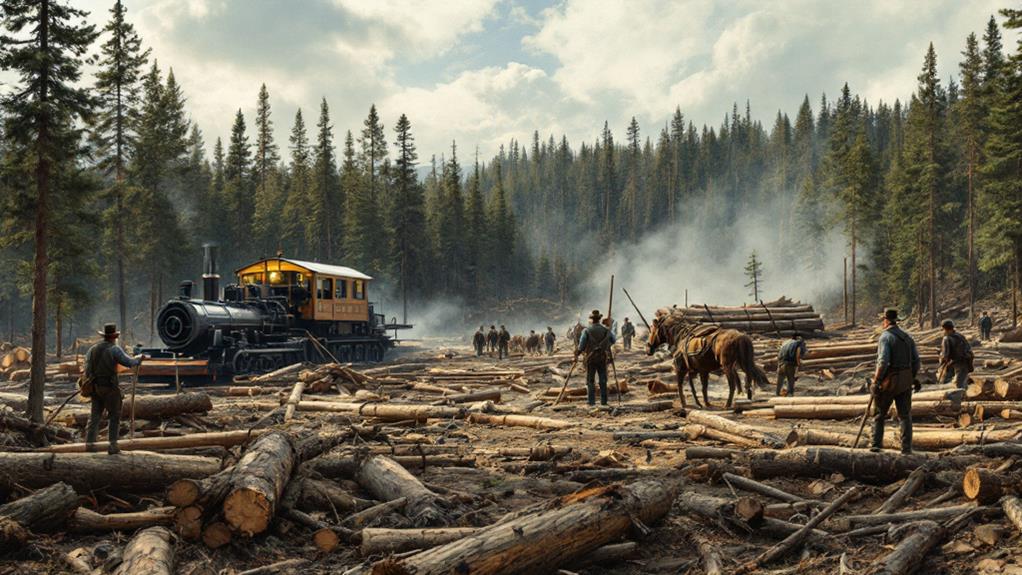The History of Forestry: From Conservation to Sustainable Management

Forestry's history spans millennia, transforming from ancient practices to modern sustainable management. You'll find that early civilizations balanced forest use with preservation, while medieval times saw structured woodland management. The Industrial Revolution brought large-scale logging, prompting conservation movements. Scientific forestry emerged, focusing on research-based practices. World Wars highlighted the need for sustainable approaches. Environmental awareness grew, leading to the development of sustainable forestry concepts. Global policies shifted towards international strategies, addressing climate change and biodiversity. Today, forestry faces challenges in balancing economic needs with environmental conservation. Exploring this path reveals how forestry has adapted to meet changing societal demands.
Ancient Forest Practices
Ancient civilizations cultivated a deep connection with forests, recognizing their essential role in daily life. You'd find that early humans relied on forests for shelter, food, and fuel. They developed ancient hunting practices that balanced their needs with forest preservation. These early societies understood the importance of maintaining healthy ecosystems for their survival.
As populations grew, you'd see the emergence of primitive land clearing techniques. People began to create small clearings for agriculture and settlements. However, they often practiced rotational farming, allowing cleared areas to regenerate over time. This early form of sustainable management helped preserve forest resources.
In many cultures, you'd uncover sacred groves and protected woodlands. These areas were off-limits for exploitation, serving as early examples of conservation. Ancient civilizations also developed basic silviculture practices, selectively harvesting trees and encouraging natural regeneration.
You'd notice that early forest management wasn't always sustainable. Some civilizations, like the Maya, faced environmental collapse due to overexploitation. However, many ancient practices laid the groundwork for modern forestry principles, emphasizing the delicate balance between human needs and forest preservation.
Medieval Woodland Management
As the Middle Ages dawned, you'd see a shift in woodland management practices across Europe. Feudal lords and monasteries began to view forests as precious resources to be managed, not just exploited. You'd notice the emergence of more structured approaches to woodland stewardship, with an emphasis on sustainable yield and long-term planning.
Coppicing techniques became widespread during this period. You'd observe woodlands divided into sections, with trees cut near ground level to encourage regrowth. This method provided a continuous supply of wood for fuel, construction, and tools. Forest grazing practices also evolved, with careful management of livestock to prevent overgrazing and damage to young trees.
Medieval woodland management introduced several key concepts:
- Rotation systems for harvesting
- Protection of specific tree species
- Establishment of forest laws and regulations
You'd find that these practices laid the foundation for modern forestry. By balancing economic needs with ecological considerations, medieval managers unknowingly set the stage for sustainable forest management. Their methods, though rudimentary by today's standards, demonstrated an understanding of the forest as a renewable resource that required careful stewardship to safeguard its long-term viability.
Industrial Revolution's Impact

In light of the Industrial Revolution, forestry practices underwent dramatic changes. You'd witness a shift from traditional woodland management to large-scale timber production, driven by the increasing demand for wood in construction, shipbuilding, and fuel. Technological advancements revolutionized logging operations, with steam-powered machinery replacing manual labor and horse-drawn equipment.
As urbanization impacts intensified, you'd notice forests near growing cities being rapidly cleared for development and resources. This led to concerns about deforestation and its consequences on the environment. In response, you'd see the emergence of scientific forestry, aimed at maximizing timber yields while ensuring forest regeneration.
You'd observe the establishment of forestry schools and the professionalization of the field during this period. Foresters began implementing new techniques like selective cutting and reforestation to maintain timber supplies. However, you'd also note that these practices often favored fast-growing, economically pivotal species, altering forest ecosystems.
The Industrial Revolution's impact on forestry set the stage for modern forest management approaches, balancing economic needs with environmental concerns.
Conservation Movement Emerges
While industrialization intensified the exploitation of forests, a countermovement began to take shape. You'd witness the birth of the conservation movement, which aimed to protect and preserve natural resources for future generations. This shift in thinking emerged as people became increasingly aware of the environmental consequences of unchecked industrialization.
The conservation movement gained momentum in the late 19th and early 20th centuries, with influential figures like John Muir and Gifford Pinchot leading the charge. They advocated for environmental protection and the maintenance of ecological balance. Their efforts led to significant changes in forestry practices and public policy.
Key developments during this period included:
- The establishment of national parks and protected areas
- The creation of government agencies dedicated to forest management
- The implementation of scientific forestry practices
You'd see a growing emphasis on sustainable forest management, which aimed to balance economic needs with environmental concerns. This approach recognized the importance of preserving biodiversity, protecting watersheds, and maintaining forest health. The conservation movement laid the groundwork for modern forestry practices, emphasizing the long-term stewardship of forest resources rather than short-term exploitation.
Scientific Forestry Takes Root

The conservation movement's emphasis on sustainable forest management paved the way for a more scientific approach to forestry. As you immerse into the early 20th century, you'll find that scientific forestry began to take root, revolutionizing the field.
You'll notice a shift from purely conservation-focused practices to methods grounded in research and data. Scientific advancement played a pivotal role in this transition, allowing foresters to better understand forest ecosystems and their dynamics. You'd see the emergence of silviculture, the science of cultivating and managing forests, which became a cornerstone of modern forestry practices.
Resource preservation remained a priority, but now it was supported by empirical evidence. You'd observe foresters adopting techniques like controlled burning, selective harvesting, and reforestation based on scientific studies. These methods aimed to balance timber production with ecosystem health.
As you investigate this era, you'll find that forestry education became more formalized, with universities establishing dedicated programs. This led to a new generation of professionally trained foresters who applied scientific principles to forest management, setting the stage for today's sustainable forestry practices.
World Wars and Timber Demand
Two world wars in the first half of the 20th century dramatically altered the terrain of forestry. As nations mobilized for conflict, you'd see an extraordinary demand for timber. Forests became strategic resources, fueling the war effort through:
- Construction of military infrastructure
- Manufacturing of weapons and equipment
- Building of ships and aircraft
This intense exploitation led to widespread timber shortages, forcing countries to reassess their forest management practices. You'd notice a shift towards more efficient logging methods and increased focus on reforestation to meet wartime needs.
In the aftermath, post-war reconstruction efforts further strained forest resources. The urgent need to rebuild cities and infrastructure demanded vast quantities of wood, pushing forestry practices to their limits. You'd observe governments implementing stricter regulations and conservation measures to prevent complete depletion of forests.
This period marked a turning point in forestry history, highlighting the critical importance of sustainable management. You'd see the emergence of new policies and international cooperation aimed at balancing timber production with long-term forest health, setting the stage for modern forestry practices.
Environmental Awareness Grows

As the world recovered from the ravages of war, a new consciousness began to emerge. You'd witness a growing awareness of environmental issues, including the impact of unchecked deforestation. This shift in public sentiment would lead to significant changes in forestry practices and policies.
In the 1960s and 1970s, you'd see grassroots activism increasing as people became more concerned about pollution, habitat loss, and species extinction. Environmental organizations gained traction, pushing for stronger conservation measures and sustainable forest management.
You'd notice that forestry professionals began to adopt a more comprehensive approach, recognizing the importance of preserving ecosystems rather than just maximizing timber production. This period marked the birth of modern environmental legislation, with laws like the U.S. National Environmental Policy Act of 1969 setting new standards for environmental protection.
As public sentiment shifts, you'd observe a growing emphasis on biodiversity, recreation, and non-timber forest products. Forestry education and research would expand to include ecology, wildlife management, and social sciences, reflecting the complex nature of forest ecosystems and their relationship with human communities.
Sustainable Forestry Concepts Develop
Building on the growing environmental awareness, sustainable forestry concepts began to take shape in the late 20th century. You'll find that these ideas evolved to balance economic needs with environmental conservation and social responsibility. Foresters and researchers started recognizing the importance of maintaining forest health while still meeting human demands for timber and other resources.
As you investigate sustainable forestry, you'll notice a shift in focus towards ecosystem services. Forests aren't just seen as timber sources anymore, but as complex systems that provide:
- Carbon sequestration to mitigate climate change
- Habitat preservation for biodiversity
- Water regulation and soil protection
You'll uncover that sustainable forestry practices aim to maintain these services while still allowing for responsible resource extraction. This approach considers the long-term health of forests, ensuring they can continue to provide benefits for future generations. You'll see how techniques like selective harvesting, reforestation, and maintaining diverse forest structures have become integral to sustainable forest management. By adopting these practices, you're contributing to a more balanced and resilient approach to forestry that considers ecological, economic, and social factors.
Global Forest Policies Evolve

During the late 20th and early 21st centuries, global forest policies underwent significant changes. You'd see a shift from localized approaches to more expansive, international strategies. As deforestation and climate change concerns grew, nations began collaborating on forest management issues.
Several key international agreements emerged, addressing global forest conservation and sustainable use. The 1992 Earth Summit in Rio de Janeiro marked a turning point, with the adoption of the Forest Principles. These non-binding guidelines encouraged countries to manage forests sustainably while considering economic and social needs.
You'd also notice the rise of forest certification programs, which aimed to promote responsible forest management practices. Organizations like the Forest Stewardship Council (FSC) and the Programme for the Endorsement of Forest Certification (PEFC) developed standards for sustainable forestry, influencing both producers and consumers.
As policies evolved, they increasingly recognized the multiple roles of forests, including biodiversity conservation, carbon sequestration, and supporting local communities. This multifaceted approach led to more integrated forest management strategies, balancing environmental, economic, and social objectives. The challenge now lies in implementing these policies effectively across diverse global regions.
Modern Challenges in Forestry
Modern forestry faces a complex web of challenges that demand innovative solutions. You'll find that climate change adaptation has become a critical concern, as forests must cope with shifting temperatures, altered precipitation patterns, and increased frequency of extreme weather events. This requires foresters to develop resilient ecosystems that can withstand these changes while maintaining their essential functions.
Biodiversity preservation is another pressing issue. As human activities continue to encroach on natural habitats, you're tasked with balancing the needs of wildlife with those of human populations. This involves creating corridors for species movement and implementing sustainable harvesting practices that minimize ecosystem disruption.
In addition to these environmental challenges, you must also navigate:
- Economic pressures to maximize timber production
- Social demands for recreational access to forests
- Technological advancements in forest management and monitoring
As a forester, you're at the forefront of developing strategies to address these multifaceted challenges. By embracing sustainable management practices and leveraging state-of-the-art research, you can help ensure the long-term health and productivity of our forests while meeting the diverse needs of society and the environment.



